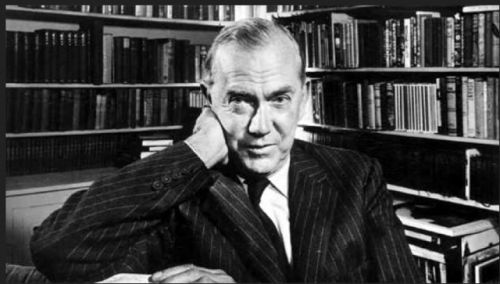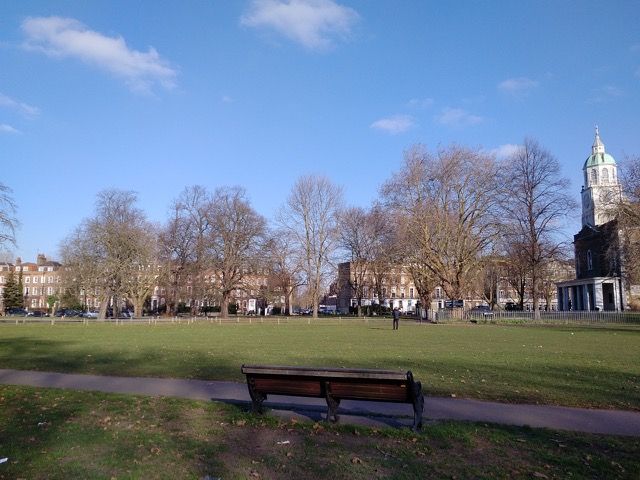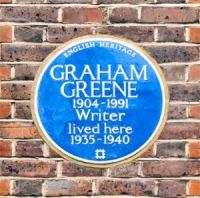The Clapham Society Local History Series — 37
Greeneland
By Peter Jefferson Smith
This article first appeared in the South London Press on 20 April 2018
(Entitled: Our man in Clapham)

In 1935, an up and coming novelist and his young family came to live at 14 Clapham Common North Side. After years of variable success, Graham Greene had achieved best seller status with his “entertainment” as he called it, Stamboul Train. He was able to sell the film rights, and it was the first of many books which established him as the leading English novelist of his time.
The Greenes had been living in a flat in Oxford. But they could now just afford London, and Graham wanted to be there, to mix in literary circles. They found a house in Clapham in a grand Georgian terrace facing the Common. After decades of dereliction, the terrace had been saved from development, and No 14 had been beautifully restored.
Greene was impressed by the surroundings. He wrote: “The whole appearance of Clapham Common is lovely, …. with the common stretching out of sight in one direction, and on three sides surrounded by little country-like shops and Queen Anne houses, a pond and in the middle of the Common the 18th century church …”
The house was Graham’s choice, but his wife Vivien instantly loved it. It had beautiful panelled rooms, an elegant staircase, and plenty of space both for the family and entertaining. Here they could live in some style.
In 1938 Greene was visited by a young would-be writer of radio scripts, Julian Maclaren-Ross, who wanted to discuss adapting Greene’s novel A Gun for Sale. The door of 14 North Side was opened by an elderly housekeeper, who tried to get rid of him as a salesman. Persuaded he was a lunch guest, she told him to go up to the drawing room – “Can’t be taking people up all those stairs at my age you know.”
Maclaren-Ross painted a picture of comfortable suburban domesticity. Before lunch, he went out with Greene to buy jugs of beer. After lunch, Vivien Green busied herself with needlework while the two men continued their literary conversation. Maclaren-Ross was taken upstairs to see the Greenes’ two young children in their nursery.

But this cosy appearance was deceptive. Another visitor was the writer Arthur Calder-Marshall, who later coined the term Greeneland for the often seedy territories occupied by Greene’s complex and troubled characters. He thought “there was another part of Graham which felt imprisoned by the comfort of the home in Clapham and his protective wife …”
Greene seems to have realised this. When the house was bombed in 1940, he had written: “It’s sad because it was a pretty house”, adding “but oddly enough it leaves one very carefree.”
When war broke out in 1939, Vivien took the children to the country. After the bombing in 1940, the house was uninhabitable; Greene left Clapham, to return only in his fiction.
By this time, the Greene’s marriage had broken down. Graham and Vivien led separate lives, though as Roman Catholics they never divorced.
In 1946, Greene met and fell in love with Catherine Walston, a rich American socialite married to a Labour peer. She was the love of his life, and their affair was the inspiration for The End of the Affair, published in 1951.
The main location is an unnamed London suburb; but it is easily identified as Clapham. The home of the heroine and her cuckolded husband is based on 14 North Side. In a key passage, she makes her way from the house, round the edge of the Common, and then through the subway at the underground station to reach the church in “Park Road”. That is St Mary’s, and the walk is one which Greene himself must have made on many a Sunday.

The house on North Side also featured in a short story, The Destructors, published in Picture Post magazine in 1954. A survivor of the War, it stands isolated on the edge of “Wormsley Common”. The location is not further identified, but the house is clearly modelled on the house the Greenes had known so well.
A gang of boys break in and systematically wreck it, imprisoning the elderly owner in an outdoor loo. They leave only one timber supporting the shell of the building, tying it to a lorry parked nearby for the night. In the morning the lorry is driven off and the house collapses. The owner is distraught while the lorry driver laughs.
When the story appeared in Picture Post, many readers criticised the graphic description of wanton destruction. Greene tried to defend himself in words which echo the final lines of the piece: “I meant it to be funny.” In fact he probably meant it to hurt, and specifically to hurt Vivien, who was bound to recognise the Clapham house she had loved. “It was to me very cruel” she said, “It was as if he enjoyed the destruction … I felt the story was a repudiation of the responsibility of family.”

The real North Side house was gutted by fire in 1960 and is now a number of flats. The facade now bears an English Heritage Blue Plaque: “Graham Greene writer lived here 1935-40.”
If his fictional use of 14 North Side is any sort of guide, Greene’s view of his old home was at best ambivalent and at worst cruelly destructive. It seems ironic that this calm and dignified Georgian façade could be a setting for such troubled imaginings. But he was a master of irony who liked to indulge in practical jokes. In the words of the lorry driver in “The Destructors”,
“You got to admit it’s funny.”